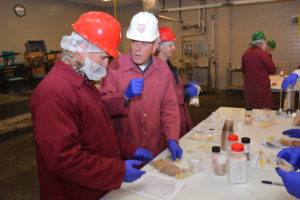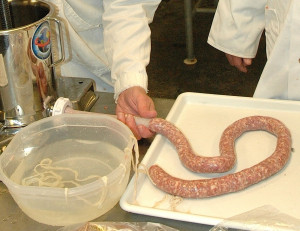 |
| Brian Payne |
Reflections on the American Goat
Federation Annual General Meeting
in
Reno, Jan. 27 & 28, 2015
By Brian Payne, Executive Director, North American
Savannah Association, www.savannahassociation.com
“I can't
think of a single time that an individual or an organization has created a
brand-new worldview, spread it and then led that tribe. There were Harley-type
renegades before there was Harley Davidson. There were digital nomads before
there was Apple. There were pop music fans before there were the Beatles and Rastafarians
before Marley. Without a doubt, a new technology creates new experiences. But
the early adopters who gravitate to it were early adopters before we got there.
Our job is to find the disconnected and connect them, to find people eager to
pursue a goal and give them the structure to go achieve that goal. But just
about always, we start with an already existing worldview, a point of view, a hunger
that's waiting to be satisfied.”
(Seth Godin, November 20, 2014)
In my
mind, “the hunger that needs satisfying” in the meat goat industry is
performance-tested genetics. The “early adopters” were the progressive
producers in the dairy, beef, swine and poultry industries that embraced
on-farm performance testing. This process, when widespread like the Dairy Herd
Improvement system in the dairy industry, paved the way for the calculation of
Estimated Progeny Difference (EPD) and Estimated Breeding Value (EBV)
calculations. The meat goat industry needs to be made aware of this step-by-step
process.
The first
step is detailed herd-management recording. Births, deaths, breeding records,
sales information, pedigrees and herd health information all needs to be
collected in order for producers to take their place in the “food industry”.
Modern consumers are demanding “traceability” and “transparency” from producers
who want to service their interest in “fresh and local” foods. They will pay
more only if they are satisfied with your attention to the health and welfare of
your livestock. You have to “prove” you are the “real thing”. “Authenticity” as
a food producer may mean close scrutiny of both your operation and the
recording system that supports your “claims of quality”. If you are only
interested in shows and blue ribbons, you have not really embraced the “meat
goat industry”. The objective of meat goat production is a consumable product,
not a family weekend experience.
The
second step is on-farm performance evaluation. If you aspire to breeding
excellence in the meat goat industry you are profit motivated and you understand
that your does are profit centers. You understand that phenotypic evaluation
through a show ring rarely correlates to maternal productive efficiency: the cornerstone
of operational profitability. If you are looking for a herd sire you would like
to have some records to be able to evaluate his transmitting ability. When you
look around at the current cadre of “breeders” you recognize that they have embraced
artificial insemination and embryo transplant technology before they embraced an
objective system that identifies production superiority. They have depended on a
“judges eye” rather than the scientific method: a weigh scale and recorded data.
It is
amazing to me that we are more than 20 years into the development of our meat
goat “business” and we still do not have widespread recognition that we need an
industry-wide system that objectively identifies superior animals. How do we
hope to compete in the modern food industry? How do we hope to be
taken
seriously by government when we are pursuing blue ribbons instead of production
data.
This
situation is ridiculous. It has come as a result of the incredible speculative
interest that pushed the Boer goat into North America’s spotlight as “the most
improved meat goat in the world”. We took this as “a given”. Then, when the
speculators left and commercial folks had to make a living with their goats,
Boer goats started to be questioned as the best breed for efficient, profitable,
larger scale production. I am confident that a new breed of meat goat
entrepreneur is wanting something more than show records to convince them of an
animal’s “genetic merit”.
It is
time to “find the disconnected and connect them”. The recent American Goat
Federation meeting in Reno has convinced me that all breeds will benefit if we
can find a way to underpin our industry with improved record keeping and data
management. Jean Harrison of Easy Keeper Herd Management took the time to participate
and demonstrated a passion and personal commitment to software product development
that can help us lead a new “tribe” (contact jean@easykeeper.com).
Dr. Ken
Andries was also in attendance as an AGF director and few would dispute his
industry leadership in developing the Kentucky State University’s Goat Herd
Improvement Program (GHIP). This is a free, on-farm, herd performance recording
program and it is already up and running. Only you will know how your animals
compare to one another. As Jean Harrison describes it, “you can’t manage what
you don’t measure”.
Dr.
Andries has opened the door to the future. It behooves all of those that
believe in the unique contributions that the caprine species can make to
sustainable agriculture to walk through this door. If you don’t, your advertisements
of genetic superiority will be meaningless. Sustainability means profitability.
Are you profitable? Why not? Do you know? (contact Dr. Andries, kenneth.andries@kysu.edu).
If you
are looking for a “structure” to advance the industry, I would say that Reno
identified three important pillars to that structure.
1) Basic
herd recording to improve management decision making.
2) On
farm performance testing to identify the keepers and culls in your operation.
3)
Industry-wide cooperation to put in place a system like the National Sheep
Improvement Program (NSIP) that can help us better predict the breeding merit
of our animals. We can’t get to this final step unless we gather the
“disconnected” and join together behind performance data collection. If your
goal is a profitable meat goat operation let us know if you want to belong to
our “tribe”.
(Contact
the writer (Brian Payne,savannahassociation@yahoo.ca), Jean Harrison, Dr. Ken
Andries or Anita Dahnke and the American Goat Federation to get “connected”
(contact Anita Teel Dahnke, atdstuff@frontier.com, www.americangoatfederation.org.)
Whether you agree or disagree with Brian’s commentary, let us
know what you think. Send your comments to goatrancher@hughes.net.



